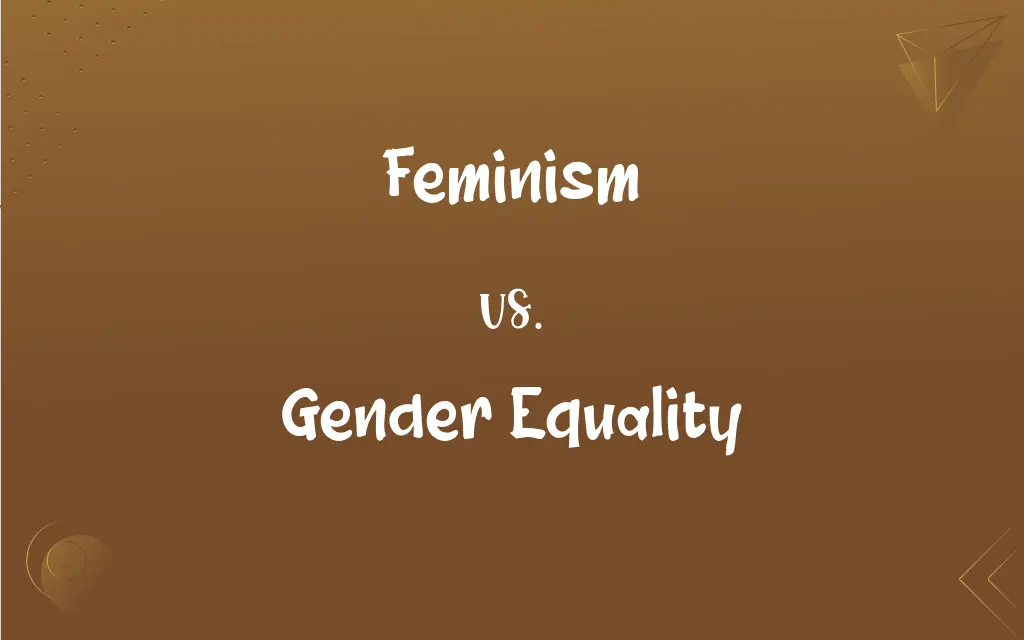Feminism vs. Gender Equality: What's the Difference?
Edited by Aimie Carlson || By Janet White || Published on October 30, 2023
Feminism is the advocacy of women's rights on the basis of equality of the both genders, while gender equality is the state of equal access to resources and opportunities regardless of gender.

Key Differences
Feminism is a complex set of ideologies and theories, primarily focused on understanding and rectifying the overt and covert sources of inequality that women face. Conversely, gender equality refers to the equal rights, responsibilities, and opportunities of all individuals, regardless of their gender, suggesting a state of equal access to resources, opportunities, and rights.
Feminism, as a movement, has historically taken various forms and aimed at achieving equal political, economic, personal, and social rights for women, focusing on areas where these rights have been limited historically. In contrast, gender equality is a broad term that encompasses any area of social, economic, or personal life where individuals should receive equal treatment, regardless of their gender.
Feminism seeks to establish educational and professional opportunities for women that are equal to those for men. On the other hand, gender equality entails that all individuals should be free to develop their personal abilities and make choices without the limitations set by stereotypes, rigid gender roles, or prejudices.
Feminism has often been misunderstood and misrepresented in public discourse, leading to misconceptions about its motives and objectives, which center around equality and dismantling patriarchal norms. However, gender equality is a more straightforward concept, focusing on an equal platform for all genders, not just the issues faced by women.
Feminism involves political campaigns and activism, focusing on issues like reproductive rights, domestic violence, maternity leave, equal pay, and discrimination. In contrast, gender equality is often considered a human rights issue, and it's pursued by various organizations, both governmental and non-governmental, worldwide.
ADVERTISEMENT
Comparison Chart
Focus
Primarily on women's rights
All genders' rights
Historical Context
Emerged from struggles specifically faced by women
Applies to broad spectrum of rights
Representation
Often misrepresented or misunderstood
More straightforward concept
Activism & Campaigns
Involves political campaigns, activism
Pursued by various global organizations
Misconceptions
Sometimes seen as anti-men or overly radical
Less controversy, seen as a fundamental human right
ADVERTISEMENT
Feminism and Gender Equality Definitions
Feminism
Feminism aims to understand and end the oppression of women.
Feminism drives the fight against harmful stereotypes.
Gender Equality
Gender equality means no one is hindered by gender-based discrimination.
Achieving gender equality requires eliminating harmful practices directed against women and girls.
Feminism
Feminism encompasses a range of political movements, ideologies, and social movements.
Feminism brought her to challenge the workplace's gender norms.
Gender Equality
Gender equality aims for equal treatment in all areas, including the workplace, politics, and society.
Gender equality in company leadership has improved its performance.
Feminism
Feminism seeks to establish educational and professional opportunities for women that are equal to those for men.
Thanks to feminism, we can enjoy more diverse professional fields.
Gender Equality
Gender equality benefits society and the economy.
Studies show that gender equality can boost economic growth.
Feminism
Feminism is often misunderstood as a movement that prioritizes women over other genders.
Despite common misconceptions, feminism focuses on equality for all genders.
Gender Equality
Gender equality is considered a human right.
He's dedicated his life to advancing gender equality worldwide.
Feminism
Feminism advocates for women's rights on the ground of the equality of the both the genders.
Her feminism prompted her to lead a women's rights rally.
Gender Equality
Gender equality refers to the equal rights, responsibilities, and opportunities of all genders.
The new policy is a big step towards gender equality.
Feminism
Belief in or advocacy of women's social, political, and economic rights, especially with regard to equality of the both genders.
Feminism
The movement organized around this belief.
Feminism
(obsolete) The state of being feminine; femininity.
Feminism
A social theory or political movement which argues that legal and social restrictions on women must be removed in order to bring about equality of the both the genders in all aspects of public and private life.
Feminism
A doctrine that advocates equal rights for women
Feminism
The movement aimed at equal rights for women
FAQs
What is feminism?
Feminism is a movement for securing equal rights for women and dismantling patriarchal norms.
What are some common misconceptions about feminism?
That it's anti-men, seeks female superiority, or is no longer needed.
Can men be feminists?
Absolutely, men can and do support and advocate for feminist causes.
How does gender equality benefit society?
It fosters a fairer society, improves economies, and supports human rights for all.
Does feminism only concern women?
While focusing primarily on women's issues, it supports equality for all genders.
What is gender equality?
It's the state of having the same rights, opportunities, and responsibilities, regardless of gender.
Is feminism still relevant today?
Yes, as long as gender inequality exists, feminism remains relevant.
Are gender equality and feminism the same?
They're interconnected but not synonymous; feminism is an activist movement, while gender equality is a desired state.
What has feminism achieved?
Progress in voting rights, reproductive rights, and equal pay, among other areas.
How has feminism changed over time?
It's evolved through waves, adapting to contemporary issues and contexts.
What are the core principles of feminism?
Equality, inclusivity, and social, political, and economic rights for women.
Can gender equality impact economic growth?
Yes, it's linked to increased growth and productivity.
What are some barriers to gender equality?
Discrimination, stereotyping, and societal and cultural norms.
How can we promote gender equality?
Through legislation, education, and changing societal attitudes.
How does gender equality affect children?
It allows them to grow in an environment free from gender-based limitations.
Does feminism support LGBTQ+ rights?
Modern feminism is generally inclusive of LGBTQ+ rights.
Why do some people oppose feminism?
Misconceptions, belief in traditional roles, or misunderstanding of feminism's goals.
How do we measure progress toward gender equality?
By analyzing data on pay, representation, health, and more.
Can gender equality change traditional roles?
Yes, it encourages flexibility in roles traditionally assigned based on gender.
Is gender equality a global issue?
Yes, it's a central goal in human rights advocacy worldwide.
About Author
Written by
Janet WhiteJanet White has been an esteemed writer and blogger for Difference Wiki. Holding a Master's degree in Science and Medical Journalism from the prestigious Boston University, she has consistently demonstrated her expertise and passion for her field. When she's not immersed in her work, Janet relishes her time exercising, delving into a good book, and cherishing moments with friends and family.
Edited by
Aimie CarlsonAimie Carlson, holding a master's degree in English literature, is a fervent English language enthusiast. She lends her writing talents to Difference Wiki, a prominent website that specializes in comparisons, offering readers insightful analyses that both captivate and inform.







































































